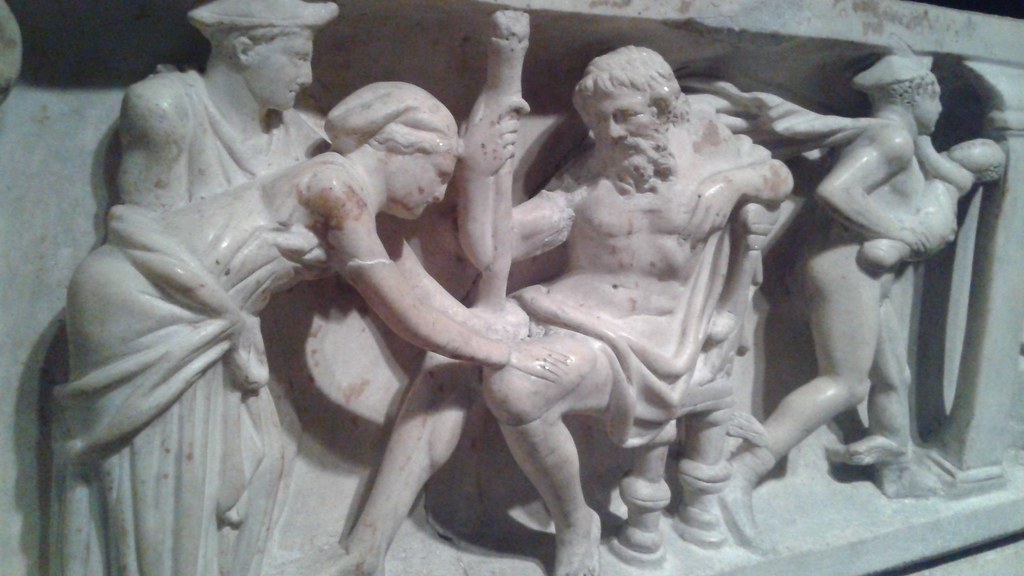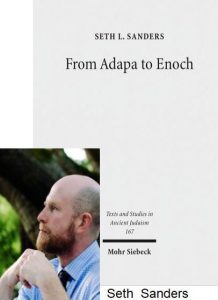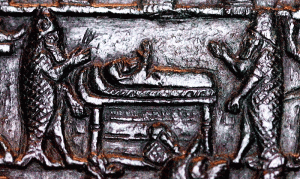This is just a curiosity post in response to someone raising a query about the golden thigh of Pythagoras and wondering if there is any connection with the use of the word thigh as a euphemism for genitalia in the Bible.
To begin, here are the sources for the idea that Pythagoras had a “golden thigh”. It is difficult to interpret the word as anything other than a literal thigh. But we will see there is more to Greek mythical associations with the thigh in the next section.

They come from “the fragments” of what ancients recorded of their knowledge of what Aristotle wrote. They are all collated in a volume available at archive.org — pages 134 and 135.
APOLLON. Mirab. 6. These were succeeded by Pythagoras son of Mnesarchus, who first worked at mathematics and arithmetic, but later even indulged in miracle-mongering like that of Pherecydes. When a ship was coming into harbour at Metapontum laden with a cargo, and the bystanders were, on account of the cargo, praying for her safe arrival, Pythagoras intervened and said: ‘Very well, you will see the ship bearing a dead body.’ Again in Caulonia, according to Aristotle, he prophesied the advent of a she-bear; and Aristotle also, in addition to much other information about him, says that in Tuscany he killed a deadly biting serpent by biting it himself. He also says that Pythagoras foretold to the Pythagoreans the coming political strife; by reason of which he departed to Metapontum unobserved by anyone, and while he was crossing the river Cosas he, with others, heard the river say, with a voice beyond human strength, ‘Pythagoras, hail!’; at which those present were greatly alarmed. He once appeared both at Croton and at Metapontum on the same day and at the same hour. Once, while sitting in the theatre, he rose (according to Aristotle) and showed to those sitting there that one of his thighs was of gold. There are other surprising things told about him, but, not wishing to play the part of mere transcribers, we will bring our account of him to an end.
Further from the same source . . . .
AELIAN, V.H. 2. 26. Aristotle says that Pythagoras was called by the people of Croton the Hyperborean Apollo. The son of Nicomachus adds that Pythagoras was once seen by many people, on the same day and at the same hour, both at Metapontum and at Croton; and at Olympia, during the games, he got up in the theatre and showed that one of his thighs was golden. The same writer says that while crossing the Cosas he was hailed by the river, and that many people heard him so hailed.
Ibid. 4. 17. Pythagoras used to tell people that he was born of more than mortal seed; for on the same day and at the same hour he was seen (they say) at Metapontum and at Croton; and at Olympia he showed that one of his thighs was golden. He informed Myllias of Croton that he was Midas the Phrygian, the son of Gordius. He fondled the white eagle, which made no resistance. While crossing the river Cosas he was addressed by the river, which said ‘Hail, Pythagoras!’
DIOG. LAERT. 8. 1. 11 (9). He is said to have been very dignified in his bearing, and his disciples held that he was Apollo, and came from the men of the north. There is a story that once, when he was stripped, his thigh was seen to be golden; and there were many who said that the river Nessus had hailed him as he was crossing it.
IAMB. V.P. 28. 140-3. The Pythagoreans derive their confidence in their views from the fact that the first to express them was no ordinary man, but God. One of their traditions relates to the question ‘Who art thou, Pythagoras?’; they say he is the Hyperborean Apollo. This is supposed to be evidenced by two facts: when he got up during the games he showed a thigh of gold, and when he entertained Abaris the Hyperborean he stole from him the arrow by which he was guided. Abaris is said to have come from the Hyperboreans collecting money for the temple and prophesying pestilence ; he lived in the sacred shrines and was never seen to drink or eat anything . . . .
But there is more. There is something suggestive about the thigh in other myths.

One that comes to mind is the birth of the god Dionysus from the thigh of Zeus. Zeus had seduced and impregnated Semele but when Semele died before her time to give birth (Zeus’s jealous wife had tricked Zeus into causing Semele’s death by appearing before her in all his divine glory) Zeus snatched up the child and sewed him into his thigh until he was ready to be born. (Dionysus thus was known as the twice-born god.)
But why the thigh? We believe that we are dealing here with a literal translation of a West Semitic idiom which euphemistically designated begetting: “sprung from one’s thigh” (yōṣe’ yerēkó, inaccurately translated in English Bibles by “loins”) merely meant “begotten by one,” his child.
(Astour, 195. Note that the Greek myth of Dionysus was borrowed and adapted from Phygia in Asia Minor.)
In the literature of ancient Greek myths thigh wounds are often euphemisms for castration. So . . .
Classical scholars are generally aware of the trope that in literature from around the world thigh wounds are often euphemistic for castration, or at least for impotence. But classicists have not noted how thigh wounds frequently symbolize not only physical impotence but political or spiritual impotence, and how such wounds also represent a temporary or permanent loss of heroic status for the wounded individual as well as a crisis for the group of people represented by that individual. This association apparently has its roots in a belief, held by many cultures, that semen was produced in several places in the body, including in the marrow of the thigh bone, and the thighs’ proximity to the testicles resulted in a close association that was nearly an interchange between the thighs and the male genitalia. Consequently, any kind of wound to the thigh, whether a wrenching, piercing, crushing, or other injury or mutilation, could represent a blow to a man’s physical and spiritual virility. . . . .
(Felton, 47f)
Some ancient physiology and learning why ankle wounds so often proved fatal: Continue reading “Thighs: Pythagorean, Biblical and Other”




